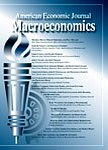-
作者:Liu, Zheng; Wang, Pengfei
作者单位:Federal Reserve System - USA; Federal Reserve Bank - San Francisco; Hong Kong University of Science & Technology
摘要:We argue that credit constraints not only amplify fundamental shocks, they can also lead to self-fulfilling business cycles. We study a model with heterogeneous firms, in which imperfect contract enforcement implies that productive firms face binding credit constraints, with the borrowing capacity limited by expected equity value. A drop in equity value tightens credit constraints and reallocates resources from productive to unproductive firms. Such reallocation reduces aggregate productivity,...
-
作者:Tjaden, Volker; Wellschmied, Felix
作者单位:University of Bonn; IZA Institute Labor Economics
摘要:We empirically establish that one-third of job transitions leads to wage losses. Using a quantitative on-the-job search model, we find that 60 percent of them are movements down the job ladder. Accounting for them, our baseline calibration matches the large residual wage inequality in US data while attributing only 13.7 percent of overall wage inequality to the presence of search frictions in the labor market. We can trace the difference between ours and previous much higher estimates to our e...
-
作者:Messina, Julian; Sanz-de-Galdeano, Anna
作者单位:The World Bank; Universitat de Girona; The World Bank
摘要:This paper examines the consequences of rapid disinflation for downward wage rigidities in two emerging countries, Brazil and Uruguay. Although wage rigidities are altered by disinflation, in neither of the two countries does price stability eliminate frictions in wage-setting mechanisms. In a context of individual wage negotiations and weak unions, disinflation in Uruguay puts an end to its history of indexation, but strong resistance to nominal wage cuts emerges. In strongly unionized Brazil...
-
作者:Melosi, Leonardo
作者单位:Federal Reserve System - USA; Federal Reserve Bank - Chicago
摘要:We conduct likelihood evaluation of a DSGE model in which firms have imperfect common knowledge. Imperfect common knowledge is found to be more successful than price stickiness a la Calvo to account for the highly persistent effects of nominal shocks on output and inflation. Our likelihood analysis suggests that firms pay little attention to aggregate nominal conditions. This paper shows that such allocation of attention is plausible because it is optimal for firms with a reasonably small size...
-
作者:Michaillat, Pascal
作者单位:University of London; London School Economics & Political Science
摘要:I develop a New Keynesian model in which a type of government multiplier doubles when unemployment rises from 5 percent to 8 percent. This multiplier indicates the additional number of workers employed when one worker is hired in the public sector. Graphically, in equilibrium, an upward-sloping quasi-labor supply intersects a downward-sloping labor demand in a (employment, labor market tightness) plane. Increasing public employment stimulates labor demand, which increases tightness and therefo...
-
作者:Huntley, Jonathan; Michelangeli, Valentina
作者单位:Congressional Budget Office; European Central Bank; Bank of Italy
摘要:We build a life-cycle model with earnings risk, liquidity constraints, and portfolio choice over tax-deferred and taxable assets to evaluate how household consumption changes in response to shocks to transitory anticipated income, such as the 2001 income tax rebate. Households optimally invest in tax-deferred assets, which are encumbered by withdrawal penalties, and exchange taxable precautionary savings for higher after-tax returns. The model predicts a higher marginal propensity to consume o...
-
作者:Barattieri, Alessandro; Basu, Susanto; Gottschalk, Peter
作者单位:University of Quebec; University of Quebec Montreal; Boston College
摘要:We present evidence on the frequency of nominal wage adjustment using SIPP data adjusted for measurement error. The SIPP is a representative sample of the US population. Our main results are: (i) The average quarterly probability of a nominal wage change is between 21.1 and 26.6 percent, depending on the assumptions used. (ii) Wage changes are much more likely when workers change jobs. (iii) The frequency of wage adjustment does not display significant seasonal patterns. (iv) The hazard of a n...


